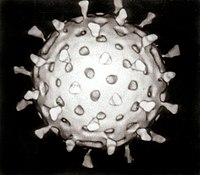
Photo from wikipedia
SFTS is an emerging infectious disease and has a high mortality rate of up to 30%. There are no licensed vaccines or antivirals against SFTS. ABSTRACT Negative-strand RNA viruses (NSVs)… Click to show full abstract
SFTS is an emerging infectious disease and has a high mortality rate of up to 30%. There are no licensed vaccines or antivirals against SFTS. ABSTRACT Negative-strand RNA viruses (NSVs) represent one of the most threatening groups of emerging viruses globally. Severe fever with thrombocytopenia syndrome virus (SFTSV) is a highly pathogenic emerging virus that was initially reported in 2011 from China. Currently, no licensed vaccines or therapeutic agents have been approved for use against SFTSV. Here, L-type calcium channel blockers obtained from a U.S. Food and Drug Administration (FDA)-approved compound library were identified as effective anti-SFTSV compounds. Manidipine, a representative L-type calcium channel blocker, restricted SFTSV genome replication and exhibited inhibitory effects against other NSVs. The result from the immunofluorescent assay suggested that manidipine inhibited SFTSV N-induced inclusion body formation, which is believed to be important for the virus genome replication. We have shown that calcium possesses at least two different roles in regulating SFTSV genome replication. Inhibition of calcineurin, the activation of which is triggered by calcium influx, using FK506 or cyclosporine was shown to reduce SFTSV production, suggesting the important role of calcium signaling on SFTSV genome replication. In addition, we showed that globular actin, the conversion of which is facilitated by calcium from filamentous actin (actin depolymerization), supports SFTSV genome replication. We also observed an increased survival rate and a reduction of viral load in the spleen in a lethal mouse model of SFTSV infections after manidipine treatment. Overall, these results provide information regarding the importance of calcium for NSV replication and may thereby contribute to the development of broad-scale protective therapies against pathogenic NSVs. IMPORTANCE SFTS is an emerging infectious disease and has a high mortality rate of up to 30%. There are no licensed vaccines or antivirals against SFTS. In this article, L-type calcium channel blockers were identified as anti-SFTSV compounds through an FDA-approved compound library screen. Our results showed the involvement of L-type calcium channel as a common host factor for several different families of NSVs. The formation of an inclusion body, which is induced by SFTSV N, was inhibited by manidipine. Further experiments showed that SFTSV replication required the activation of calcineurin, a downstream effecter of the calcium channel. In addition, we identified that globular actin, the conversion of which is facilitated by calcium from filamentous actin, supports SFTSV genome replication. We also observed an increased survival rate in a lethal mouse model of SFTSV infection after manidipine treatment. These results facilitate both our understanding of the NSV replication mechanism and the development of novel anti-NSV treatment.
Journal Title: Journal of Virology
Year Published: 2023
Link to full text (if available)
Share on Social Media: Sign Up to like & get
recommendations!